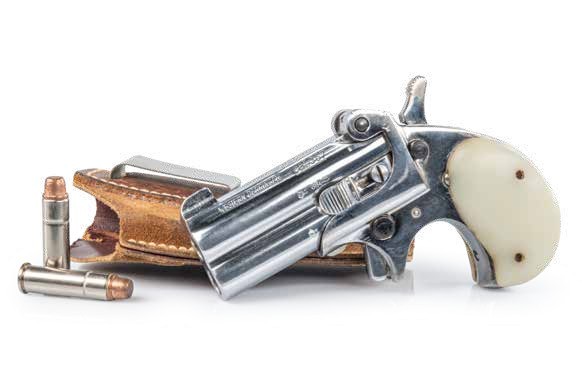EDITOR’S SHOT KEVIN MICHALOWSKI
DAD’S DERRINGER
SMALL GUN, BIG MEMORIES


When it comes to “pocket guns,” the conversation really must start with the derringer. The history of the original pocket pistol goes back to about 1852, when Henry Deringer introduced his tiny muzzleloading caplock. About 15,000 of these little single-shot pistols were manufactured, most of them in .41 caliber and with barrels from 1.5 inches to 6 inches — perfect for concealed carry.
We apparently arrived at the generic term “derringer” because of a misspelling in the press following the murder of Abraham Lincoln. John Wilkes Booth used one of Henry Deringer’s pistols to assassinate the president.
The design almost universally identified as a derringer nowadays first appeared in 1866, when Remington manufactured the Model 95. The company made about 150,000 of these double-barrel pistols featuring an exposed hammer and a tip-up barrel. The most common chambering was the .41 Rimfire, which produced a muzzle velocity of only about 425 feet per second. (For reference, that is about half the speed of a .45 ACP round.) Thank goodness the .41 Rimfire fell by the wayside, but the design of the pistol has remained largely unchanged.
That’s the style of gun my father first carried — illegally, I might add — during the riotous era of the mid-1960s in Milwaukee. He toted the gun in a crappy little suede IWB holster. He bought the gun mail-order from Herter’s in Minnesota. It’s a little chrome pistol marked on the sides of the barrels: “Western Derringer cal .357” on the left and “Made in Germany” on the right. The top of the barrels says, “Herter’s Inc. WASECA/ Minnesota” and carries a four-digit serial number. I’m pretty sure he paid less than $20 for the gun.
Recently, I have fired the gun a few times to get a feel for it, but I have never launched full-house .357 Magnum rounds. Maybe I should ... just to see the fireball and feel the recoil once or twice.
I bring out the little pistol every now and then, wipe it down and reminisce. My father bought the gun before I was born.
He would sometimes load it with .357 shotshells and dispatch gophers and chipmunks and then complain about the recoil. Even as a kid, I began to understand that guns that were easy and comfortable to carry could be uncomfortable to shoot.
But there is a reality that comes with this dichotomy: If you need a gun, nothing else will do. The best gun to have in a gunfight is the gun you have with you when the gunfight starts. So even though that little derringer is not perfect, it is better than nothing. And it was all he could afford at the time.
Years later, as a young gun writer, I asked him why he chose that gun and how he intended to use it should the need ever arise. His plan was to use the gun to keep people off his car if he got caught up in violence as he drove to or from work. He said he figured attackers would likely back off if he fired his two shots at the guy closest to the driver’s door. Then he could keep driving to get away from trouble. (Maybe it wasn’t a perfect plan, but at least he had some idea of what he wanted to do.) He said the gun was cheap and easy to hide. This was important, as there were no concealed carry permits issued in Wisconsin in the 1960s, and it would be nearly 40 years before the courts would declare open carry legal. So keeping the gun out of sight was critical.
I may never carry this little derringer as a defensive tool, but I’ll keep it forever. My kids will likely sell it off after my passing, but until then, I have some great memories and cool stories surrounding this little Western Derringer.
And maybe that’s all I need.